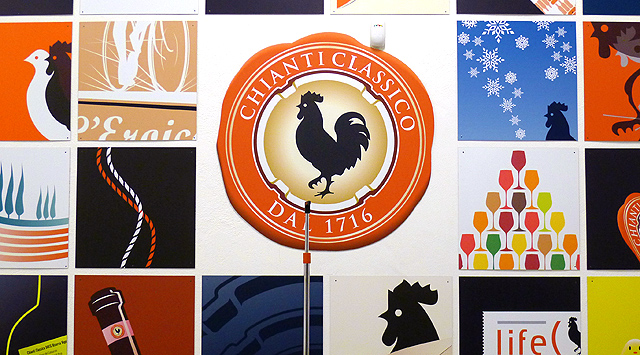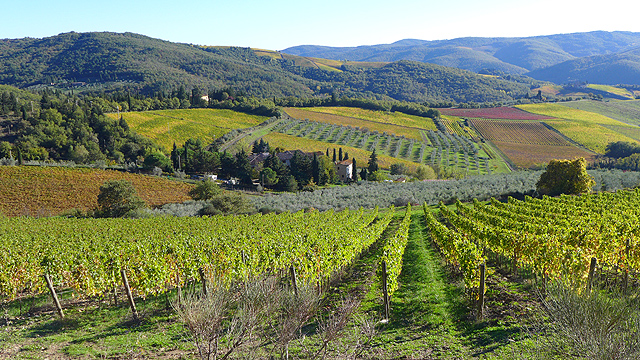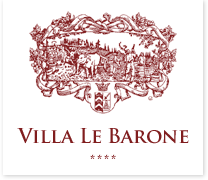
Do you really know what is “Chianti Classico” wine? We are sure you don’t! To know what it is, you have to read the most fascinating new book Chianti Classico: The Search for Tuscany’s Noblest Wine , written by Bill Nesto and Frances Di Savino, which has just been published by the University of California Press.
The book not only tells the story of this famous wine since the 1500s until today, but it also reveals the closely intertwined socio-economic story of the Chianti territory. It is also a story of the laws, decrees, institutions and lobbying bodies which sought to protect the place of origin of wines and have led to the modern Chianti Classico, with its trademark, the Black Rooster (Gallo Nero).
We hope that the book’s short summary below will give Villa le Barone’s magazine readers the desire to read the book!
For centuries, “Chianti was valued as a special wine from the rocky hills of three river valleys between Florence and Siena in the heart of Tuscany: Val di Pesa, Val di Greve and Val d’Arbia”. This place, the original Chianti, has been mired in conflict for much of its history… and it was the dispute over the borders of the Chianti zones in the 20th century that came to be known as the “War of Chianti” (Guerra del Chianti). In 11 chapters, Bill Nesto and Frances di Savino describe the evolution of Chianti from the 1500s through Bettino Ricasoli in the 1800s, to the twenty-first century, including the birth of the competing “Chianti Classico” and “External Chianti” zones in the twentieth century. It tells how Chianti Classico entered the global market, mainly commercialized in “fiaschi” (flasks), wrapped in traditional reed, “sala”. At the same time, Italian wine merchants started to sell red wine under the brand “Chianti” coming from all over Tuscany, and even Rome, Naples, Sicily and other Italian regions. Tellingly, Italy did not sign the international Madrid Agreement to protect “indications of source or appellation of origin” in the late nineteenth century. In 1924 a law called Disposizioni per la difesa dei vini tipici (Provision for the defense of typical wines) gave precedence to the concept of “Vini Tipici “ over that of wines from delimitated areas, the result of a 4-year legislative odyssey. The Chiantigiani immediately fought back, and in May 1924, the “Consortium for the defense of the typical wine of Chianti and its mark of origin” was created in Radda in Chianti, and choose the Black Rooster, the emblem of the medieval Lega del Chianti, as its “mark of origin”. Within 6 months the consortium grew to 189 members. It was soon called “Rooster Consortium” (Consorzio del Gallo). The authors continue describing the divisions and fights between Chianti Classico and External Chianti and their respective consortia after World War 2. In 2014, a new Chianti Classico DOCG (Denominazione Origine Controllata e Guarantita) discipline was adopted. The Chianti Classico zone now covers the full townships of Radda in Chianti, Gaiole in Chianti , Castellina in Chianti, and Greve in Chianti (which includes the hamlet of Panzano). The denomination also includes part of the townships of Castelnuovo Berardenga, Tavarnelle Val di Pesa, Barberino Val d’Elsa, Poggibonsi and San Casciano Val di Pesa. Today, the discussions are continuing: Is it important to identify “subzones” of Chianti Classico? Should there be “township labeling”?

“Essentially, Chianti Classico is a Sangiovese varietal wine”, already referenced in 1552 by Girolamo da Firenzurola in his long-lost treatise, “Sopra la agricultura”. It is Baron Bettino Ricasoli who, in 1870, re-established Sangiovese as Chianti’s star variety, sharing the stage with Canaiolo and Malvasia. But the authors state in conclusion of their chapter “The Secret of Sangiovese” that creating a new category of 100% Sangiovese Chianti Classico would allow “Sangiovese and terroir to shine”. Organic and biodynamic viticulture is now growing. It began in Panzano, where the Villa le Barone hotel is located, and where the Chanti Classico producers agreed together to adopt “sustainable viticulture practices”.
There are about 380 grower-bottlers of Chianti Classico, and Bill and Frances have selected a number of them, mostly the smaller to midsize ones and present them in one of the last chapters.
You will be able to savor the best Chianti Classico wines at Villa le Barone, together with the best traditional dinners prepared by our cooks!
“This is not a simple tale”, as Bill Nesto, MW and founder of the Wine Studies Program at Boston University, and Frances Di Savino, attorney and co-author, state in the first chapter of Chianti Classico: “With its many twists and turns, peaks and valleys, Chianti is a territory worthy of an epic. Framed by Florence to its north and Siena to its south, Chianti is a land of quintessential beauty and culture. It is the timeless paesaggio (landscape) in the background of a Renaissance painting. It is a land of castles, chapels, bell towers, farmhouses, hills, oaks, cypresses, olive groves, and vineyards. It is an authentic place which gave birth to an iconic…wine, also known as Chianti.”
You have to come to Chianti!
